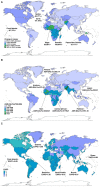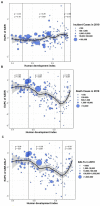Measurement of the burdens of neonatal disorders in 204 countries, 1990-2019: a global burden of disease-based study
- PMID: 38264240
- PMCID: PMC10803531
- DOI: 10.3389/fpubh.2023.1282451
Measurement of the burdens of neonatal disorders in 204 countries, 1990-2019: a global burden of disease-based study
Abstract
Background: Neonatal disorders are facing serious public health challenges. Previous studies were based on limited data sources and had a narrow geographical scope. We aim to understand the trends of alteration in the burden of neonatal disorders from 1990 to 2019 in 204 countries and territories.
Methods: Data were investigated from the Global Burden of Disease Study 2019. First, we visualized the burden of neonatal disorders using the number of cases and the age-standardized incidence rate (ASIR), death rate (ASDR), and disability-adjusted life years (ASR-DALYs) from 1990 to 2019. Second, estimated annual percentage changes (EAPCs) were used to evaluate the temporal trends of disease burden during different periods. Finally, the sociodemographic index (SDI) and human development index (HDI) were used to determine whether there exists a correlation between socioeconomic development level, human development level, and potential burden consequences.
Results: Overall, in the past 30 years, the ASIR trends have remained relatively steady, whereas the ASDR and ASR-DALYs have declined. However, the burden of neonatal disorders varied greatly in various regions and countries. Among 21 regions, the ASIR trend had the largest increase in Central Latin America (EAPC = 0.42, 95%CI = 0.33-0.50). Conversely, the ASDR and ASR-DALYs experienced the largest decrease in Central Europe (EAPC = -5.10, 95%CI = -5.28 to 4.93) and East Asia (EAPC = -4.07, 95%CI = -4.41 to 3.73), respectively. Among 204 countries, the ASIR (EAPC = 3.35, 95%CI = 3.13-3.56) trend in Greece displayed the most significant increase, while the ASDR (EAPC = 1.26, 95%CI = 1.01-1.50) and ASR-DALYs (EAPC = 1.26, 95%CI = 1.03-1.49) trends in Dominica experienced the most substantial increase. Furthermore, there was a strong correlation between the EAPCs in ASIR, ASDR, ASR-DALYs, and SDI or HDI in 2019, with some exceptions. In addition, countries with elevated levels of HDI experienced a faster increase in ASDR and ASR-DALYs for neonatal disorders.
Conclusion: Although the burden of neonatal disorders shows a downward trend from 1990 to 2019, it is still not optimistic. It is necessary to implement a multi-pronged approach to reduce the increasing burden of neonatal disorders.
Keywords: death rate; disability-adjusted life years; global trend; incidence; neonatal disease burden.
Copyright © 2024 Xin, Luo, Xiang, Zhu, Niu, Feng, Sun, Zhang, Zhou and Yang.
Conflict of interest statement
The authors declare that the research was conducted in the absence of any commercial or financial relationships that could be construed as a potential conflict of interest.
Figures





Similar articles
-
Disparities in the global burden of tracheal, bronchus, and lung cancer from 1990 to 2019.Chin Med J Pulm Crit Care Med. 2023 Mar 28;1(1):36-45. doi: 10.1016/j.pccm.2023.02.001. eCollection 2023 Mar. Chin Med J Pulm Crit Care Med. 2023. PMID: 39170872 Free PMC article.
-
Temporal trends of tracheal, bronchus, and lung cancer between 2010 and 2019, in Asian countries by geographical region and sociodemographic index, comparison with global data.Thorac Cancer. 2023 Jun;14(18):1668-1706. doi: 10.1111/1759-7714.14912. Epub 2023 May 1. Thorac Cancer. 2023. PMID: 37127553 Free PMC article.
-
Burden of esophageal cancer between 2010 and 2019 in Asian countries by geographical region and sociodemographic index: A comparison with global data.Thorac Cancer. 2023 Aug;14(24):2361-2407. doi: 10.1111/1759-7714.15026. Epub 2023 Jul 17. Thorac Cancer. 2023. PMID: 37455657 Free PMC article.
-
Trends in the incidence and DALYs of schizophrenia at the global, regional and national levels: results from the Global Burden of Disease Study 2017.Epidemiol Psychiatr Sci. 2020 Jan 13;29:e91. doi: 10.1017/S2045796019000891. Epidemiol Psychiatr Sci. 2020. PMID: 31928566 Free PMC article.
-
The changes in global burden of autoimmune diseases two years after the COVID-19 pandemic: a trend analysis based on the Global Burden of Disease Study 2021.J Transl Autoimmun. 2025 Apr 24;10:100289. doi: 10.1016/j.jtauto.2025.100289. eCollection 2025 Jun. J Transl Autoimmun. 2025. PMID: 40342869 Free PMC article. Review.
Cited by
-
Mortality Projections, Regional Disparities in the Burden of Neonatal Disorders, and the Status of Achieving SDG Targets by 2030 in South Asia: Insights from the Global Burden of Disease Study 2021.J Epidemiol Glob Health. 2025 Mar 13;15(1):43. doi: 10.1007/s44197-025-00359-0. J Epidemiol Glob Health. 2025. PMID: 40080234 Free PMC article.
-
Global, regional, and national burden of neonatal diseases attributable to particulate matter pollution from 1990 to 2021.Front Public Health. 2025 Jun 9;13:1556340. doi: 10.3389/fpubh.2025.1556340. eCollection 2025. Front Public Health. 2025. PMID: 40552221 Free PMC article.
References
-
- Collaborators GBDU-M . Global, regional, and national progress towards sustainable development goal 3.2 for neonatal and child health: all-cause and cause-specific mortality findings from the global burden of disease study 2019. Lancet. (2021) 398:870–905. doi: 10.1016/S0140-6736(21)01207-1, PMID: - DOI - PMC - PubMed
-
- Liu MX, Li HF, Wu MQ, Geng SS, Li K, Lou BW, et al. . Associations of preterm and early-term birth with suspected developmental coordination disorder: a national retrospective cohort study in children aged 3–10 years. World J Pediatr. (2023) 19:261–72. doi: 10.1007/s12519-022-00648-9, PMID: - DOI - PMC - PubMed
Publication types
MeSH terms
LinkOut - more resources
Full Text Sources
Miscellaneous

